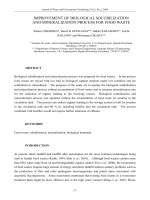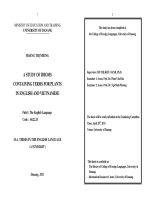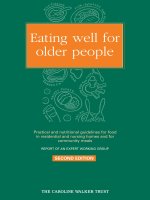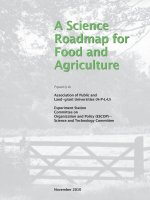Plants for food and fibre notes
Bạn đang xem bản rút gọn của tài liệu. Xem và tải ngay bản đầy đủ của tài liệu tại đây (1.29 MB, 42 trang )
Unit 2: Plants for Food
and Fibre
Ms. Lyons
Topic 1: People and Plants
Plants are used by humans for food and fibre.
Uses of Plants
Plants have numerous uses, some examples include:
- Using carbon dioxide and giving off oxygen
-
The base of most Food Webs
-
Other examples??
Shelter
Cleaning and filtering water
Prevention of soil erosion
Plants for Food
75% of the world’s food supply is based on seven crops
Wheat
Barley
Rice
Maize (corn)
Potatoes
Cassava
Sorghum
Plants and the Final Product
Cocoa tree – Chocolate
Canola – Vegetable Oil
Seaweed – Ice-cream, Yogurt
Sugar beets – Sugar
Can you think of other examples??
Plants for Fibre
Cotton – Used for clothing, plastics and papers
Hemp – The oldest cultivated plant in the world, the first bible was printed on hemp. Early sails and
ropes were made of hemp
-
The Advantages of Hemp:
Can be harvested in one year
Hemp paper can be recycled more times and more easily than wood paper
Hemp is not eaten by most insect pests
Plants for Fibre Continued
Flax – 2-3 times as strong as cotton! Used in varnishes and some types of linoleum.
Plants for Medicine
More than 7000 medicines today are made from plants.
White willow bark →Aspirin (pain relief)
Opium Poppies → Morphine (strong pain killer)
Cinchona trees → Quinine (used to prevent malaria)
Plants for Transportation and
Construction
Rubber Trees – brought about tires, which has enabled cars, planes and spacecraft
Wood is used in construction around the world
Plants are also used for fuel – ethanol-blended gasoline.
Topic 2: Structure and Adaptations
Plant Roots
Often the plant is the tip of the Iceberg!
Roots perform several important functions
-
They absorb water and minerals
-
The support and anchor the plant
-
They store food for the plant
Types of Plant Roots
Taproot: Main root, which can reach deep into the ground with numerous small roots, coming out of
it.
Root hairs: Increase the surface area in which the plant can absorb water and nutrients.
Fibrous Roots: Shallow system of similar sized roots that quickly soak up moisture.
Carrots, beets, turnips, radishes and parsnips are all edible roots!
Diffusion and Osmosis
Two key functions that allow roots to absorb water and dissolved substances.
Diffusion: A tendency of particles to move from an area of high concentration to an area of low concentration.
- E.g. Particles of perfume spread throughout the room.
Differentially Permeable Membrane: Allows some materials to pass through, yet keeps other materials out. E.g. Marbles
and sand in a mesh bag.
Osmosis: A type of diffusion in which water moves from a high concentration to a low concentration.
Functions of the Stem
1)
Transports water and nutrients between the leaves and the roots.
2)
Provides support for the plant
3)
Food storage
Leaves
Leaves – The energy producers of the plants
Leaves contain chlorophyll the pigment that makes them green.
Photosynthesis takes place in the leaves.
CO2 + H2O + Sunlight + Nutrients → Sugar + O2
Gases like Carbon Dioxide and oxygen enter and leave the plant through little openings in the leaves called stomata.
Guard cells around the stoma (singular of stomata) regulate how much comes and goes.
Respiration and Transpiration
Respiration: Process by which plants release CO2 and take in O2, this takes place at night and is
slower than photosynthesis.
Transpiration: The loss of water from a plant through evaporation, acts as a pump using osmosis to
move water up the stem of the plant.
Topic 3: Plant Reproduction and
Breeding
Selective Breeding: People choose specific plants with specific characteristics and encourage these
plants to reproduce.
-
Canola was made by the selective breeding of rapeseed.
Genes: The part of the cell that controls plants’ characteristics.
Types of Reproduction
Sexual: Involves the specialized seeds and fruits of two plants.
Asexual/vegetative reproduction: Occurs when a parent plant grows plants from its roots, stems, or
leaves.
-
E.g. Grafting – taking the branch of one tree and attaching it to another.
Seed Plant Reproduction
Cones: The part of the tree that has a series of wooden scales.
Female cones contain ovules (eggs); Pollen grains containing sperm develop on the smaller male cone.
When the two meet the sperm swims down the pollen tube and fertilizes the egg.
Pollination: The process of pollen traveling to the female cone.
Flowers
A flower’s main job is to attract insects that will spread the plant pollen to other plants.
Parts of a Flower
Stamen: Male part of the flower
The pistil has 3 main parts
Pistil: Female part of the flower
Petals: Usually brightly coloured
Sepals: Green parts found underneath the flower.
Stigma: Sticky tip of the pistil that catches pollen
Style: The tube connecting the stigma and the ovary
Ovary: A tiny chamber that holds the ovule (eggs)
Continued
The Stamen has 2 parts:
Filament: The stalk
Anther: The tip, produces the pollen
Parts of the Flower
Pollination 3 Steps
1) Pollen grain lands on the stigma
2) A pollen tube grows down the style into the ovary and enters an ovule
3) A sperm travels down the tube to fertilize the egg.
Seed to Fruit
Once a plant is pollinated a seed is formed, inside the seed is a tiny living plant called an embryo which
is surrounded by food to keep it alive.
Fruit: A growing ovary of a plant, which swells and protects the seeds until they are ripe.









